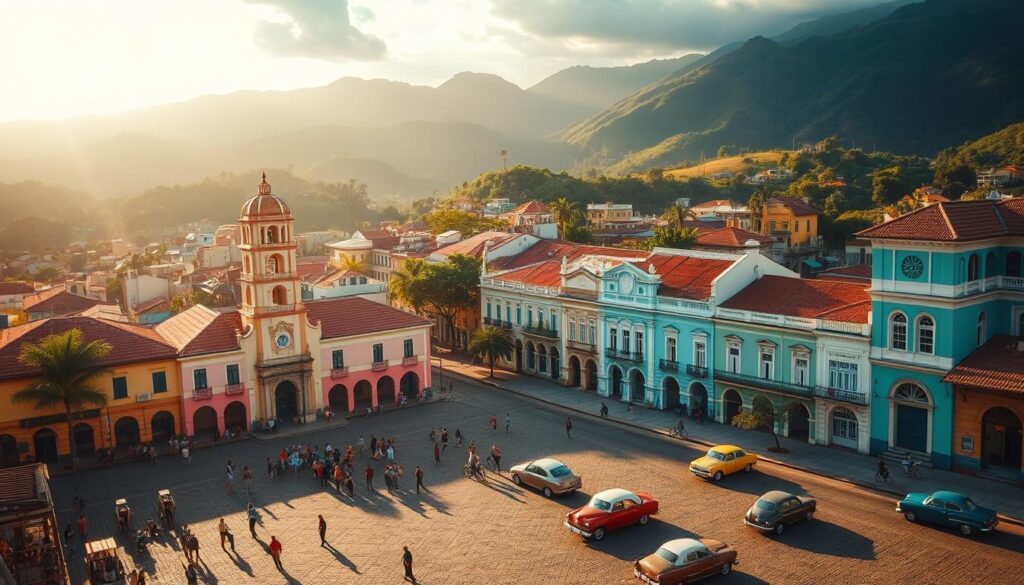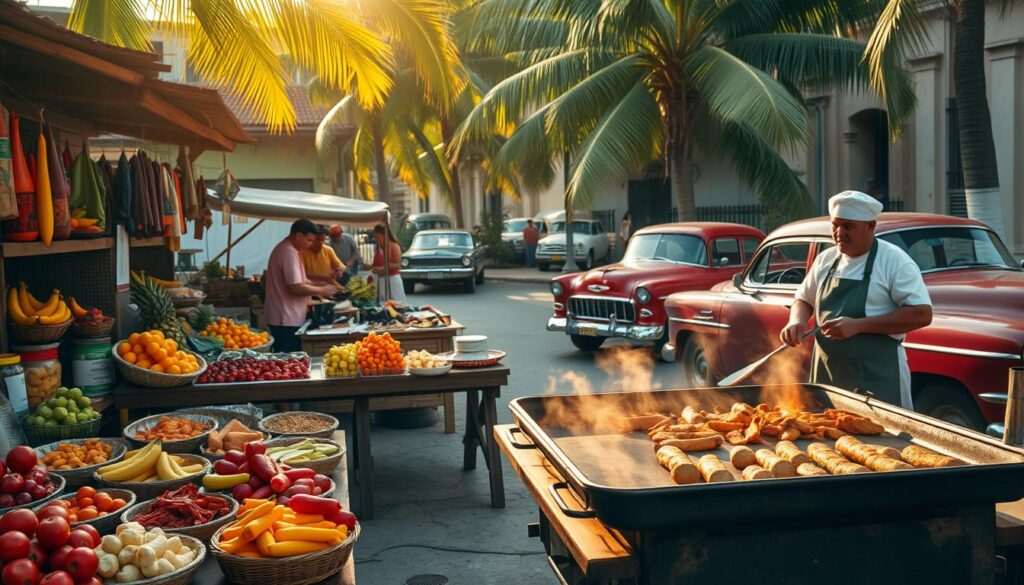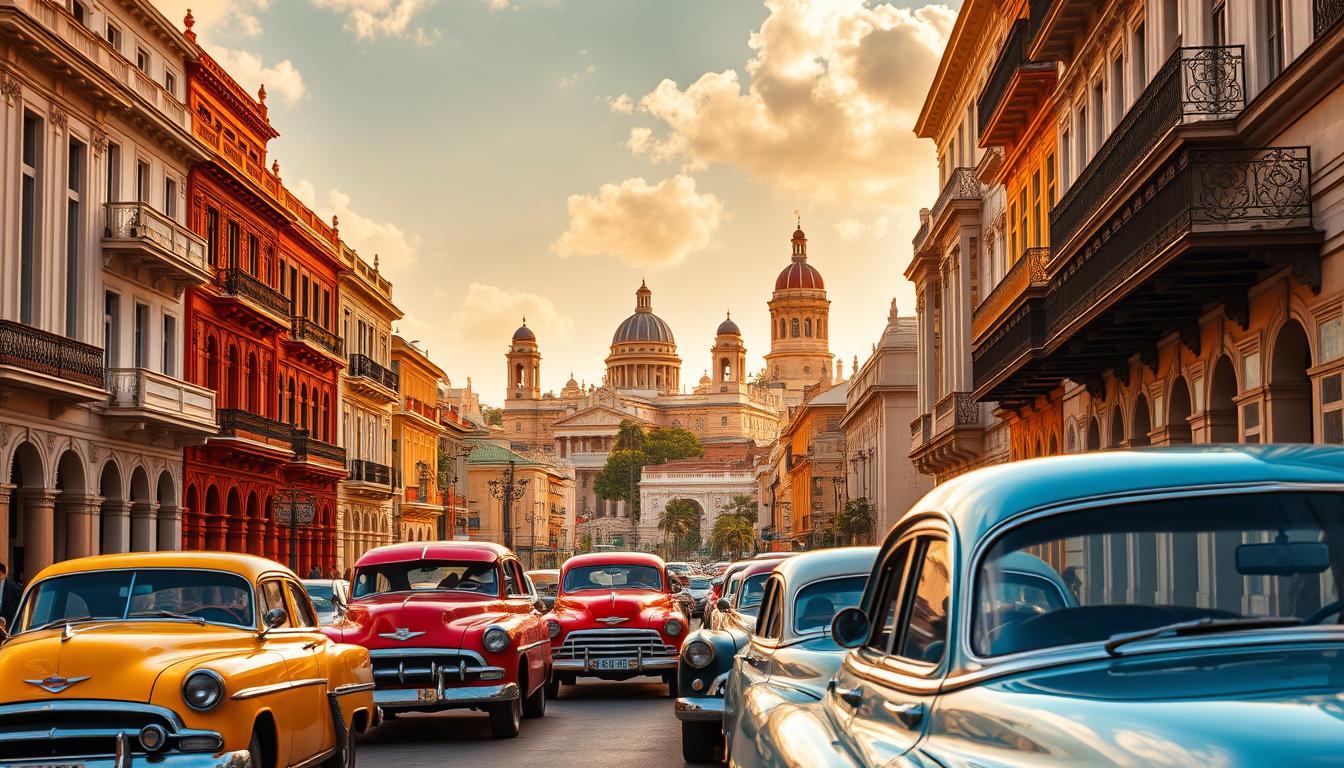Cuba, a Caribbean island nation, is a treasure trove of vibrant culture, stunning beaches, and rich history. As a traveler, you’re probably eager to explore the top destinations that Cuba has to offer.
From the colorful streets of Havana to the breathtaking beaches of Varadero, Cuba’s diverse landscapes cater to all interests. Whether you’re fascinated by history, culture, or simply relaxing on the beach, Cuba has something for everyone.
Key Takeaways
- Explore the vibrant culture of Cuba
- Visit the historic city of Havana
- Relax on Varadero’s stunning beaches
- Discover Cuba’s rich history
- Experience the diverse landscapes of Cuba
Discovering Cuba: A Caribbean Paradise
Cuba is a mix of Spanish history, African rhythms, and Caribbean charm. It’s a place that draws travelers with its unique culture and stunning beauty. Americans find it appealing because it offers a blend of the familiar and the exotic.
Cuba’s Unique Appeal to American Travelers
Cuba gives American travelers a special cultural experience. It combines Spanish history, African influences, and indigenous heritage. This mix is seen in Cuba’s music, dance, art, and food.
Visitors can enjoy Cuban hospitality, see historic sites, and feel the lively music. Cuba’s calm and beautiful landscapes are a nice break from the US’s fast pace. You can walk Havana’s colorful streets, try a cigar, or relax on Varadero’s beaches.
Best Times to Visit the Island
The best time to visit Cuba is from December to April. The weather is mild and perfect for exploring. This is great for Americans who like cooler weather and less humidity.
| Season | Months | Weather | Activities |
|---|---|---|---|
| Dry Season | December to April | Mild and Pleasant | Sightseeing, Outdoor Activities |
| Wet Season | May to November | Hot and Humid | Festivals, Indoor Activities |
Visiting in the shoulder season (May to June or November to December) is also good. Prices are lower, and there are fewer tourists, making for a more peaceful trip.
Havana: The Vibrant Capital City
Havana, Cuba’s capital, is full of history, culture, and life. Its historic center, Old Havana, is a UNESCO World Heritage Site. It has cobblestone streets and colonial buildings that take you back in time.
Old Havana (Habana Vieja) UNESCO World Heritage Site
Old Havana is a top spot in Havana. It has beautiful streets, historic sites, and a lively nightlife. You can see the Plaza de la Catedral and the Cathedral of Havana. The Museum of the City is nearby, showing Havana’s rich history.
The area is famous for its boutique hotels, art galleries, and Cuban food restaurants.
The Iconic Malecón Seawall
The Malecón Seawall is an 8-mile promenade along Havana’s coast. It offers stunning ocean views. It’s a favorite spot for both locals and tourists, best at sunset.
People enjoy walking here, watching street performers, and feeling the lively vibe.
Revolutionary Landmarks and Museums
Havana has many landmarks and museums about Cuba’s fight for freedom. The Museum of the Revolution is a key place to visit. It has exhibits on Cuba’s history, including Fidel Castro’s revolution.
Other important sites include the Granma Memorial and the José Martí Memorial. They honor the revolution’s heroes.
In summary, Havana mixes history, culture, and fun perfectly. It’s a city that will capture and inspire you. With its lively atmosphere, rich past, and famous landmarks, Havana is a must-see for travelers.
Varadero and Cuba’s Breathtaking Beaches
Varadero Beach is a true Caribbean paradise. It has soft white sand and clear blue waters. It’s a top spot in Cuba, loved by visitors worldwide for its calm beauty and fun activities.
At Varadero, you can relax on the beach or try water sports like snorkeling and kayaking. The beach is full of resorts. Many offer all-inclusive deals for different tastes.
The Premier Resort Destination
Varadero Beach is famous for its powdery white sand and crystal-clear waters. It’s great for swimming, snorkeling, or just enjoying the sun. Resorts along the beach provide many amenities for a comfortable stay.
Fernando Ortiz, a Cuban scholar, once said, “Cuba is a land of breathtaking beauty, where the sea meets the shore in a dance of splendor.” This captures Varadero Beach’s beauty, where Cuba’s natural wonders are on full display.
Cayo Coco and Cayo Guillermo
Cayo Coco and Cayo Guillermo are perfect for a quiet getaway. These islands off Cuba’s coast are untouched and peaceful, away from city life.
The beaches here are untouched, with clear turquoise waters and powdery white sand. You can snorkel, dive, or just relax on the beach.
Playa Ancón near Trinidad
Playa Ancón is a must-see near Trinidad. It’s known for its beautiful views and calm waters, perfect for swimming and sunbathing.
Surrounded by greenery, Playa Ancón adds to its natural beauty. You can try water sports or explore Trinidad, a UNESCO World Heritage Site.
Trinidad: Cuba’s Colonial Gem
Trinidad, a town in southern Cuba, brings Cuba’s colonial past to life. It’s a top spot for those who love Cuban culture and old buildings. With its cobblestone streets and rich history, Trinidad offers a unique look at Cuba’s heritage.

Plaza Mayor and Colonial Architecture
The Plaza Mayor is Trinidad’s heart, a beautiful square with colonial buildings. The square is filled with colorful, restored buildings. Visitors can walk the cobblestone streets, enjoying the lively atmosphere and admiring the old buildings.
The town’s buildings show its long history, with many from the 18th and 19th centuries. The bright colors, ornate balconies, and grand courtyards make it feel like the past.
Valle de los Ingenios (Sugar Mill Valley)
Outside Trinidad is the Valle de los Ingenios, a valley once key to Cuba’s sugar industry. The valley has many sugar mills and plantations turned into museums. Visitors can explore, learning about sugar’s role in Cuba’s economy and culture.
A visit to the Valle de los Ingenios offers a peek into Cuba’s past. It’s a chance to see the valley’s beauty and historic sites. It also helps understand the lives of those who worked in the sugar mills and plantations.
Viñales Valley: Natural Beauty and Tobacco Country
The Viñales Valley is a stunning area in western Cuba. It’s famous for its mogotes and tobacco farms. Nature lovers and those interested in Cuban culture will find it fascinating.
Mogotes and Limestone Formations
The valley’s mogotes, or limestone formations, create a breathtaking landscape. These karst structures, shaped over millions of years, are home to many plants and animals.
Tobacco Plantations and Farm Visits
Viñales Valley is known for its tobacco plantations. They are key to Cuba’s cigar industry. Visitors can see how Cuban tobacco is grown and made. Many farms let you try some of Cuba’s famous tobacco products.
| Attraction | Description |
|---|---|
| Mogotes | Limestone formations creating a unique landscape |
| Tobacco Plantations | Farms where Cuban tobacco is cultivated and processed |
| Cueva del Indio | A cave featuring indigenous artifacts and rock formations |
Cueva del Indio (Indian Cave)
The Cueva del Indio is a must-see in the valley. It’s a cave filled with ancient artifacts and beautiful rock formations. Exploring it gives you a glimpse into the region’s past.
Main Attractions of Tourists in Cuba: Cultural Experiences
Tourists in Cuba get to enjoy a rich cultural scene. They can dive into music, dance, cigars, and rum. Cuba’s culture is a mix of history, creativity, and passion.
Cuba’s music is a big part of its identity. Visitors can hear Cuban music like salsa, son, and rumba. Music fills the streets of Havana, Santiago, and Trinidad.
Cuban Music and Dance: Salsa, Son, and Rumba
The island’s music is full of energy and cultural depth. Tourists can watch live shows, take dance classes, or just enjoy the vibe. Salsa is a big part of Cuban culture, with its fast beats and lively dance.
Cigar and Rum Tourism
Cuba is known for its top-notch cigars and rum. Visitors can see how cigars are made and taste Cuba’s best rums. Cigar and Rum Tourism lets people see how these traditions are kept alive.
| Cultural Experience | Location | Description |
|---|---|---|
| Cigar Factory Tour | Havana | Learn about the production of Cuba’s famous cigars |
| Rum Distillery Tour | Santiago de Cuba | Sample Cuba’s finest rums and learn about the distillation process |
| Live Music Performance | Trinidad | Enjoy traditional Cuban music and dance |
Art Galleries and Cultural Centers
Cuba’s art scene is vibrant, with many galleries and cultural centers. These places show off local artists’ work, from modern to traditional crafts. Visitors can see exhibits, join workshops, or just enjoy the art.
In conclusion, Cuba offers a wide range of cultural experiences. From music and dance to cigars and rum, there’s something for everyone. Whether it’s live shows, factory tours, or art galleries, Cuba’s culture is waiting to be explored.
Santiago de Cuba: The Cradle of Revolution
In southeastern Cuba, Santiago de Cuba is a city key to the country’s past. It’s a place of history, culture, and revolution. If you’re into history or culture, you must see this city.
Castillo de San Pedro de la Roca (El Morro)
The Castillo de San Pedro de la Roca, or El Morro, is a famous spot in the city. This 17th-century fortress is a UNESCO World Heritage Site. It sits on a rocky cliff, giving amazing views of the sea and land.
Revolutionary History and Carnival Celebrations
Santiago de Cuba is rich in revolutionary history and vibrant culture. You can learn about its fight for freedom at places like the Museo de la Lucha Clandestina. This museum tells the city’s story in the struggle for independence.
The city’s carnival is a colorful show of music and dance. It’s a celebration of Cuba’s culture. The parades and dances capture the essence of Santiago de Cuba.
Cuban Cuisine and Culinary Experiences
Exploring Cuban cuisine is like a trip through the island’s history and culture. It’s a mix of traditional dishes, coffee, and cultural experiences.

Cuban food combines Spanish, African, and Caribbean tastes. You’ll find dishes like ropa vieja, arroz con pollo, and empanadas. Try these at paladares, private restaurants, for a real taste of Cuba.
Traditional Cuban Dishes and Paladares
Here are some Cuban dishes you must try:
- Ropa vieja: shredded beef in a tomato sauce
- Arroz con pollo: chicken and rice with saffron and spices
- Empanadas: pastry pockets with meat, cheese, or veggies
Paladares are family-run spots. They offer a cozy setting to dive into local culture and food.
Coffee Plantations and Tastings
Cuba is known for its coffee. You can visit coffee plantations to see how it’s made. Some top spots include:
- Finca El Escambray: famous for quality coffee and views
- Cafetal Buenavista: a historic spot with tours
There are also coffee tastings. You can try some of Cuba’s finest brews.
Food Markets and Cooking Classes
Local food markets like El Mercado de Cuatro Caminos in Havana are great for Cuban food. You can also take cooking classes to learn how to make traditional dishes.
Some top cooking classes are:
- Cuban cooking classes at La Cocina de Lola
- Traditional Cuban cuisine classes at El Aljibe
Conclusion: Planning Your Cuban Adventure
Cuba is a unique mix of history, culture, and natural beauty. You can explore vibrant Havana or relax on Varadero’s beaches. Cuba has something for every traveler.
Use a Cuba travel guide to plan your trip. Visit during the shoulder season for fewer crowds and lower prices. Cuba’s rich culture and landscapes make it perfect for an authentic Caribbean experience.
As you explore, dive into the local culture. Enjoy Cuba’s music, dance, and food. Whether you love history, culture, or beach time, Cuba will leave you with unforgettable memories.
FAQ
What are the must-see attractions in Cuba?
Cuba has many attractions. You can see the colorful streets of Havana. Also, visit the beautiful beaches of Varadero and the historic town of Trinidad.
What is the best time to visit Cuba?
The best time to visit Cuba is from December to April. The weather is mild and pleasant during this time.
What are the top cultural experiences to have in Cuba?
Cuba is rich in culture. You can enjoy Cuban music and dance. Visit cigar and rum factories and explore art galleries and cultural centers.
What are the most popular beaches in Cuba?
Varadero Beach is very popular. It has white sand and clear waters. Other great beaches include Cayo Coco, Cayo Guillermo, and Playa Ancón.
What is the history of Trinidad, Cuba?
Trinidad is a colonial town in southern Cuba. It’s full of history and culture. The Plaza Mayor is a beautiful square with colonial buildings. The Valle de los Ingenios is a valley with sugar mills and plantations.
What can I expect to see in Viñales Valley?
Viñales Valley is in western Cuba. It’s known for its natural beauty and tobacco plantations. You’ll see mogotes, tobacco fields, and the Cueva del Indio, a cave with indigenous artifacts.
What is the significance of Santiago de Cuba?
Santiago de Cuba is where the revolution started. It has historic landmarks like the Castillo de San Pedro de la Roca, a 17th-century fortress.
What is Cuban cuisine like?
Cuban cuisine mixes Spanish, African, and Caribbean flavors. Try dishes like ropa vieja, arroz con pollo, and empanadas. Don’t miss trying traditional Cuban food at paladares, or private restaurants.
Can I visit coffee plantations in Cuba?
Yes, Cuba is famous for its coffee. You can visit coffee plantations to learn about coffee production and taste Cuban coffee.
Are there opportunities to take cooking classes in Cuba?
Yes, you can take cooking classes in Cuba. Learn about Cuban culinary traditions and make traditional dishes like a local.

